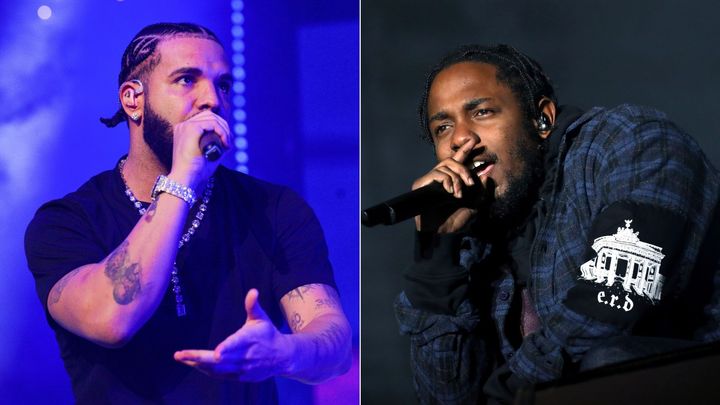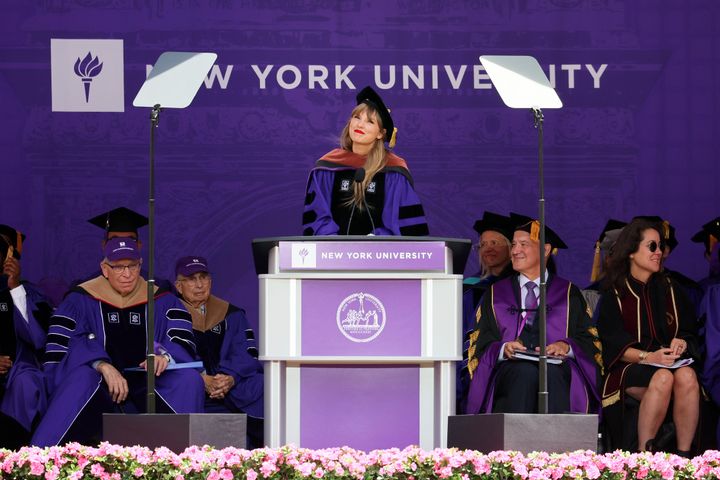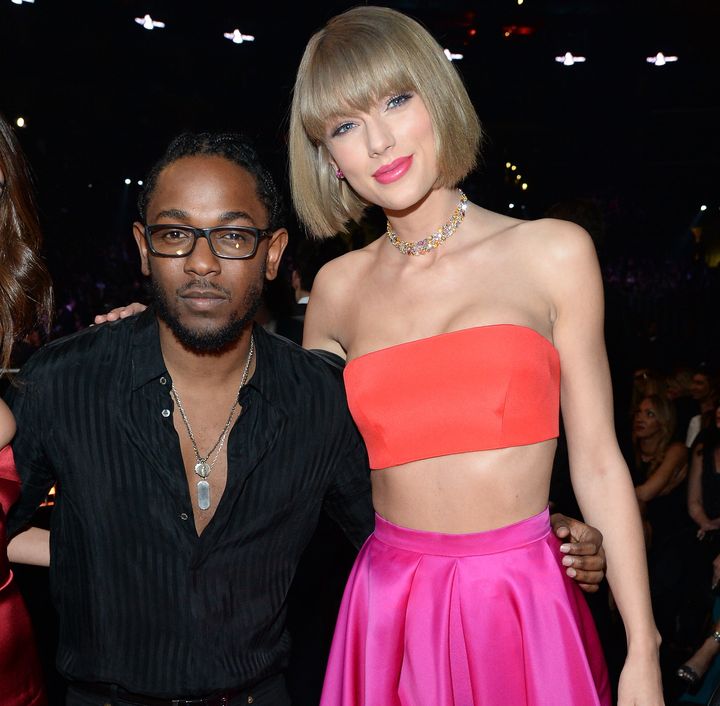The Next Lesson In High School English Class? Taylor Swift And The Drake-Kendrick Beef.
John Keats and Maya Angelou, please make room on the syllabus for the new kids on the block: Taylor Swift and Kendrick Lamar.
In some middle school and high school English classes throughout the country, teachers are using Swift’s “The Tortured Poets Department” album, as well as Lamar and Drake’s very recent rap battle, as a means to get their students pumped up about poetry.
Advertisement
In one widely shared video, a high school English instructor who goes by @stillateacher on TikTok says that her formerly Drake-devoted students are convinced that Lamar has won the dramatic, weekslong lyrical feud.
“They were ready to throw down for Kendrick,” the teacher says in the clip. “I have students who hate reading who are doing the most meticulous close reading of these lyrics that I have ever seen. They’re finding subtle quadruple-entendres [in Lamar’s work] and explaining them eloquently to their peers.”
(To be fair, Lamar has a leg up; in 2018, the Compton, California, rapper ― known for his dynamic wordplay and thematically rich albums ― became the first artist from a genre other than jazz or classical to earn a Pulitzer Prize for music.)
Advertisement
In southern Georgia, Kaitlyn Lee’s ninth grade class in English language arts, or ELA, is also highly plugged into the Drake-Lamar rap beef.
“We have a fairly informal classroom culture, and I encourage discussion about current topics so that we can see how ELA applies to them,” Lee told HuffPost. “They’ve had some strong opinions on how both artists have approached each other, as well as the allegations about Drake’s personal life.”
A quick study, Lee has tried to squeeze some literary lessons out of her student’s enthusiasm. For example, the class recently dissected one particular lyric from Lamar’s diss track “Not Like Us.”
“Tryna strike a chord and it’s probably A minor” is a triple-entendre, Lee explained to her class, playing on musical theory and Drake’s biracial background ― the key of A minor has no sharps or flats, meaning it’s comprised of only white piano keys and no black ones ― while also referencing the allegations that Drake had inappropriate relationships with underage girls, which he denied on a track of his own.

Prince Williams/Rick Kern/Getty Images
Advertisement
“This is bringing poetry to life in a way that my students can relate and connect to,” Lee said.
Of course, the English teacher has one caveat and a reminder for her students when they discuss the feud: Violence and confrontation are never the best options, and “some of this rap battle is probably for clout and publicity.”
Still, she said, a good teaching moment is a good teaching moment.
Other English instructors have seized on their Swiftie students’ excitement over “The Tortured Poets Department,” an album that leans into its literariness with references to Welsh poet Dylan Thomas and songwriter-poet Patti Smith.
Kim Randolph, a seventh grade honors English teacher in Denton, Texas, is a Swiftie through and through, as are many of her students. On release day for “The Tortured Poets Department,” she let her class listen to the album as they worked independently.
“The boys immediately latched on to ‘Fortnight,’ but only because they were thinking of Fortnite the game,” Randolph said. “But that led us into a fun conversation about the word ‘fortnight’ and where they might encounter it in the real world.”
Advertisement
They’ve also used the album to explore examples of figurative language: the metaphors in “Fortnight” (“All my mornings are Mondays stuck in an endless February”), similes in the album’s title track (“I scratch your head, you fall asleep, like a tattooed golden retriever”), and imagery in “My Boy Only Breaks His Favorite Toys” (“I’m queen of sandcastles he destroys”).
Randolph’s class is into the beef between Lamar and Drake, too. “Middle schoolers love drama, so this is right up their alley,” she joked.
Katherine Mummert teaches ELA for grades nine through 12 at an alternative high school in Marshalltown, Iowa. Two years ago, she started teaching a seminar course for 12th grade students titled “Taylor Swift and 19th Century Literature: A Comparison of Themes.” In the class, they treat Swift’s discography as poetry and find parallels in her lyrics with Victorian-era poets like Robert Browning.
“We watch her live performances and music videos and read through the lyrics line by line,” Mummert told HuffPost. “Once we have a grasp on what Swift’s intended message is, we look at a piece of literature from the 19th century that discusses the same thematic topics.”

Dia Dipasupil/Getty Images
Advertisement
A real crowd favorite is the song “No Body, No Crime” and the accompanying text “Porphyria’s Lover” by Browning, both of which deal with crimes of passion.
Mummert thinks teens have been deep-diving into the lyrics of their favorite pop songs since the dawn of the genre; it’s only now that teachers and professors are beginning to “give credibility” to the pastime.
Today, there are even college classes devoted to the study of Swift’s lyrics. One of Harvard’s latest English courses, Taylor Swift and Her World, is taught by professor Stephanie Burt, a literary critic, poet and massive Swiftie.
Burt told HuffPost that she’s excited to see music fans getting so obsessive and nerdy about some of the more absorptive pop works of late: deciphering Lamar’s Drake takedowns line by line on the website Genius, for instance, or looking for Easter eggs and allusions to past work in Swift’s growing catalog. Podcasts like “Dissect” and “Song Exploder” pick apart lyrics and artists’ oeuvres just like an advanced college English class would.
“I recommend close-reading songs; otherwise we’re not doing the songs justice,” Burt told HuffPost. “‘Close reading’ is really just a name for sustained attention to a work of art that uses words.”
Advertisement

Kevin Mazur/Getty Images
Brian Mooney is an assistant professor of education at Fairleigh Dickinson University, but he used to teach English at High Tech High School in North Bergen, New Jersey.
Back in 2015, when Lamar released “To Pimp a Butterfly,” Mooney’s freshman English class explored the album as a text in conversation with Toni Morrison’s novel “The Bluest Eye.”
Mooney and his class considered the “Black is beautiful” cultural movement of the 1970s while making contemporary connections to Lamar’s album in a way that he says deepened their study of both.
“My students were surprised at the thematic similarities, including ideas about mental health, white beauty standards, racism and internalized oppression,” Mooney told HuffPost.
Advertisement
“In some ways, my students weren’t surprised that we studied a hip-hop album because it was really no different than studying Shakespeare,” he said. “It was just as complex, provocative and intellectually rigorous, but in a way that affirmed their cultures, identities and lived experiences.”
Mooney put his students’ essays, as well as their Lamar- and Morrison-inspired art, on a blog that made its way to the rapper’s camp, which led Lamar to drop by Mooney’s classroom. NPR made a short doc about his visit that’s well worth a watch.
“When Kendrick visited our classroom, he really came to learn from my students,” the professor said. “He listened closely to their writing, responded thoughtfully to their ideas and became part of our learning community.”
Not surprisingly, the kids were bowled over by Lamar’s appearance and how much he took away from them.
Advertisement
“I remember one student reflecting on the visit who said that if a random person walked into my classroom that day, they wouldn’t have been able to tell who was the teacher, who were the students and who was the Grammy award-winning rapper,” Mooney said. “It broke down those walls, which is what great teaching often does.”
Ultimately, Mooney believes that educators have a responsibility to keep up with youth culture because it’s where their students are deeply immersed. He’s happy to see so many teachers and professors finding fresh and interesting ways to center pop music, especially when it comes to hip-hop — arguably the largest youth culture movement of the past 50 years.
“We have to remember that we don’t just teach content. We teach human beings within social, cultural and political contexts,” Mooney said. “I believe that in order for students to learn, they need to know their teachers care about them, their lives, their interests and their passions.”

Comments are closed.